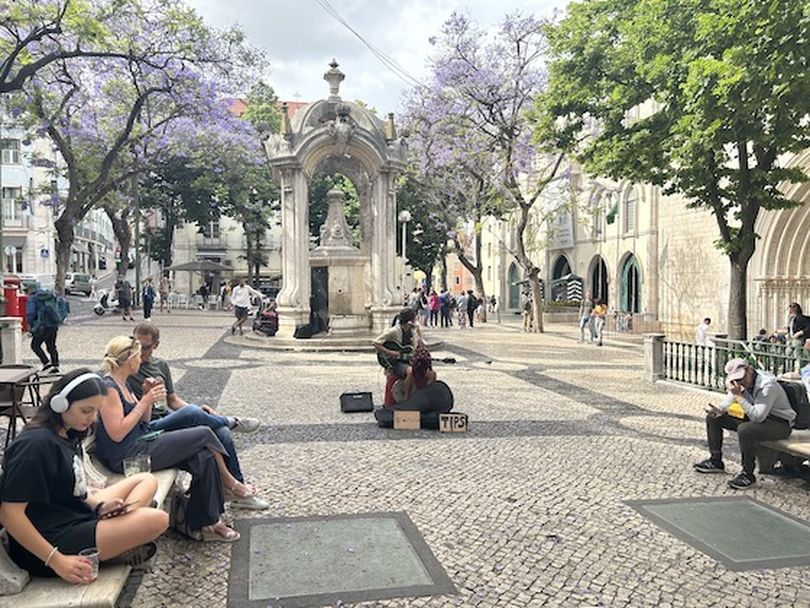Riding a Tuk-tuk is a fine way to see Lisbon

Continuing my recounting of the Spain-Portugal trip that my wife Mary Pat Treuthart and I took in late May:
I’m not a big breakfast guy. At home, a couple of cups of coffee is enough to hold me until mid-morning. But when I travel, it’s a different story.
That’s when I tend to stuff myself, particularly when I stay at a hotel that offers a sumptuous buffet, which was the case on our first morning at the Lisboa Carmo Hotel. Not only could I eat as many eggs as I wanted (scrambled and/or hard-boiled), I could dine on bacon, sausage, several different kinds of fruit and as many pastries as I could balance on a plate.
And, of course, I ordered coffee, which when it arrived was just what I needed it to be. So, I had no complaints, except for maybe the fact that the breakfast service stopped at 10:30 a.m., which seemed a little early.
Not that the cutoff affected me too much. I’m typically wide awake long before that, even when I’m stumbling around a foreign country encumbered by jet lag. But the people I was now traveling with – not just my wife Mary Pat but our friends Ann and Matt – are night owls (Mary Pat is a self-professed vampire, though one who doesn’t drink blood – I think).
So, while I was digesting my eggs and such, and working on maybe my third café americano, the three of them rambled in maybe 10 minutes before the deadline. I give the friendly staff full credit for letting us stick around until nearly 11.
That is when we started our day in Lisbon. Unsure about how to proceed, and knowing that walking up and down Lisbon’s steep streets would prove a bit too arduous for our aging legs, we asked the employees behind the hotel desk for advice. And they suggested taking a Tuk-tuk tour, the point being that so many of the streets are narrow that an open-air Tuk-tuk was the most efficient way of getting around.
Which is what we did. Our guide, whom we met an hour or so later, was a friendly, approachable guy, though I’m not sure he had much more than a rough grasp of Lisbon history. And he was a bit pricey (25 euros a head for an hour, 35 for 90 minutes and so on). Still, it was a sunny day, we had eaten our fill and were anxious to get an overall feel for the city’s sights, so off we went.
Here are some of the highlights of our tour:
The Alfama district: Once a rough, working-class neighborhood set outside the city walls, Alfama is now a tourist hotspot. Its streets are a twisting maze of cobblestone, all perched along the city’s steep hills. And it features a couple of spots that offer great views.
Quiosque Portas do sol: Even if you don’t want to stop at this café for food, you may want to pause awhile just to take in the sights. Which is what we did, though in between taking a number of selfies I did buy a couple of bottles of cold water.
Miradouro da Senhora do Monte: Maybe the most magnificent overlook in Lisbon, this high point provides a panoramic view that includes some of the city’s main features, from the Graça Church and Convent to the distant Tagus estuary.
Mosteiro de São Vicente de Fora: Said to house one of the most important monasteries in Portugal, and a prime example of mannerist architecture, the 17th-century church is built on a site that dates to 1147.
Santa Engracia Church, aka the National Pantheon: Located near the Mosteiro de São Vicente de Fora, the church – which took centuries to complete – is the burial place of any number of Portuguese celebrities, from politicians to writers, singers to soccer players (the main one being the world-renown footballer Eusébio).
Praça do Comércio: Set along the city’s riverfront, this is Portugal’s largest plaza and was once where the king of Portugal lived until the 1755 Lisbon Earthquake destroyed the palace. It is now a Portuguese national monument.
With the tour ended, our driver returned us to our hotel. By this time, we were hungry again. So, we walked to the nearby plaza, Largo do Carmo – the same plaza that, 48 years before, had been filled with soldiers and citizens – and enjoyed sandwiches at the Quiosque do Carmo beer garden.
Ann and Matt then began feeling the effects of that bane of travelers, jet lag, which had been exacerbated by hours under the bright sun, and so we all decided to take a couple of hours to recuperate. That left us primed for dinner, which Mary Pat had reserved for 7:30 at a place called Antigo de 1 Maio.
Unlike so many other contemporary eateries, nothing about the place felt trendy, which the four of us found refreshing. The older man who greeted us seemed like someone straight out of a movie casting office, gruff and no-nonsense but amiable enough despite not knowing a word of English. (Side note: The language difficulty didn’t matter because our friend Matt speaks an impressive level of Portuguese, among several other languages).
In any event, we got seated and soon were served a range of traditional Portuguese dishes, the sum of which proved to be just the right thing to cap off the first full day of our Lisbon adventure.
Next up: Lunch on the Tagus.
